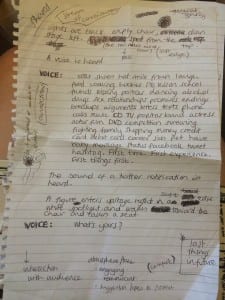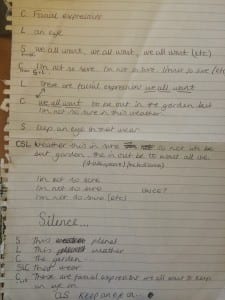Today, we were given a task to create a script expanding on the voice of someone or something. As a starting point, we were given the surroundings and beginning lighting and setting states so we were all creating from the same point. What was asked from each of us was to expand on a voice that guided the piece, but we were also tole to think about lighting, positioning, structure, atmosphere and character. At the time, I wrote within my subconscious without deliberately creating something specific but it wasn’t very exciting and I wasn’t interested in what I had actually created. Therefore, I went away and made a few short scripts within the same setting but with different outcomes. I then chose any one of these scenarios to speak about in the next teaching session where I justified my choices and decisions.
This task was obviously set in order for each of us to introduce ourselves to the concept of creating, individually. Seeing as though I have had experience in directing and devising previously, this wasn’t too difficult. However, in the past I have worked in a group where I have facilitated ideas with others and so I have had other opinions and voices to work with. Therefore, this task was slightly different. Although it didn’t spur ideas for my future performance, it helped me to envision what kind of atmosphere I would like. I like the idea of creating a connection between the audience and myself. I don’t know right now how I imagine doing so but after a few mind-mapping sessions I hope to be a step closer to an idea. I also know that I want to make use of spotlights to help with the intimacy and experiment with coloured lighting. My final automatic writing script was fragmented and while it made sense, it wasn’t structured in sentences. I like this structure as it keeps the audience alert as they are un-expectant of what will follow. I will bare this in mind when creating my final performance piece.

We had been set another task which we had to complete in groups of 3. We were all asked to bring in something in written form, such as a newspaper article, a cooking book, lyrics or a novel etc, from which we each chose a sentence at random. Our task was to create a short piece, using only these three sentences from three separate mediums, and experiment with repetition, volume, pace, silence, atmosphere and intention. We were able to create tension and humour whilst speaking the words of something absurd. This task obviously presented to us the abilities we have of creating a performance piece. No matter what the concept is, if the intentions are thought through well and we experiment with artistic elements, then a performance can be created.
